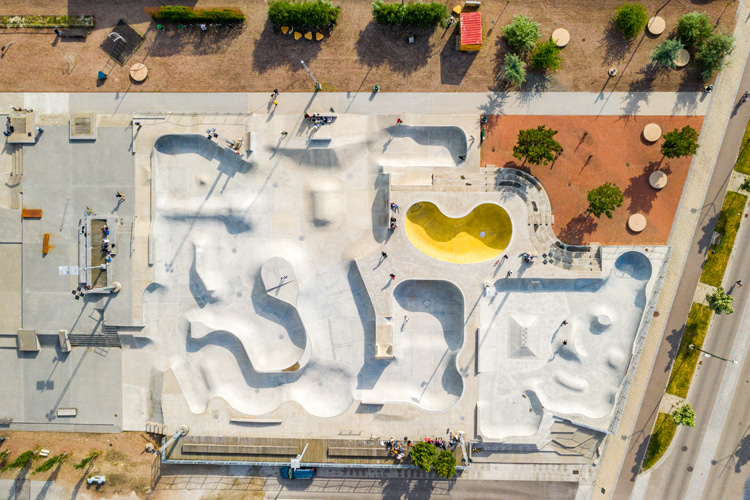World Skate, the world governing body for the sport of skateboarding, announced the creation of an official skateboard facility certification.
The scope of this regulation is to define the technical and safety features of multipurpose skateboard facilities used for recreation, sport, and competition activities.
The Skateboard Facility Certification rulebook applies to indoor and outdoor facilities, both temporarily and permanently built.
The skatepark certification protocol can be used by city councils, national sports federations, and local authorities to build an officially sanctioned skating facility.
The following guidelines ensure that skateparks follow strict conventions and directives when skateboarding earned Olympic status.
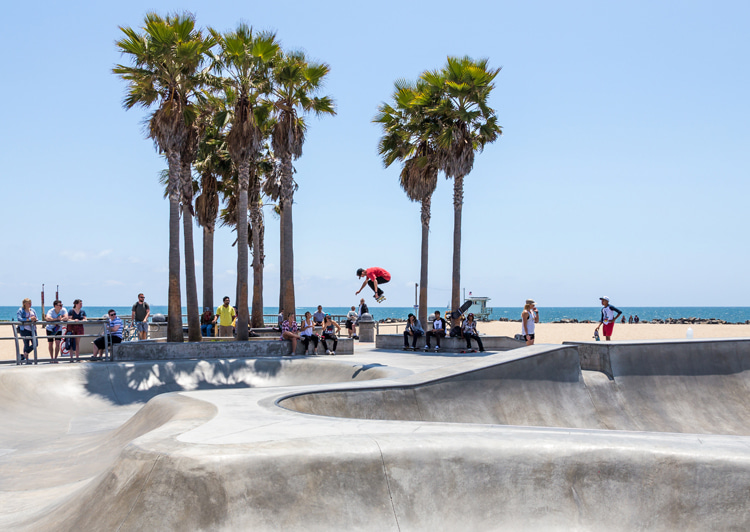
1. Classes of Certification
The World Skate certification system comprises two classes of certification:
- Recreational (R-Class certification): identifies facilities, or sections of facilities, fit for skateboarding recreational and initiation activities by offering safe and functional areas for every level of skateboarding practice. While these facilities are essential to modern city life, they aren't fit to run official World Skate-sanctioned events;
- Competition (C-Class certification): identifies facilities, or portions of facilities, fit to host competitions at various levels depending on the certified rating class;
Certifications are issued with reference to specific disciplines recognized by World Skate as follows:
Park Style
A park-style course is composed of interconnected radial transitions and banked walls, built at various declinations, depths, and heights, which are configured in a layout that provides athletes with the necessary amount of riding speed for consistent flow.
The design must also include several integrated technical features, providing athletes with a larger variety of trick options.
Street-Style
A street-style course is composed of features and elements typically found in an urban environment, such as stairs, rails, ledges, and banks.
The configuration of these elements must allow athletes to have enough speed for consistent flow when approaching all obstacles on the course.
The course must contain various individual features (or obstacles) that allow equal opportunity for athletes to perform tricks despite one's stance (regular and goofy).
While C-Class is specifically designed to host competitions of a specific discipline, R-Class courses, or sections of courses, can include design features for both disciplines.
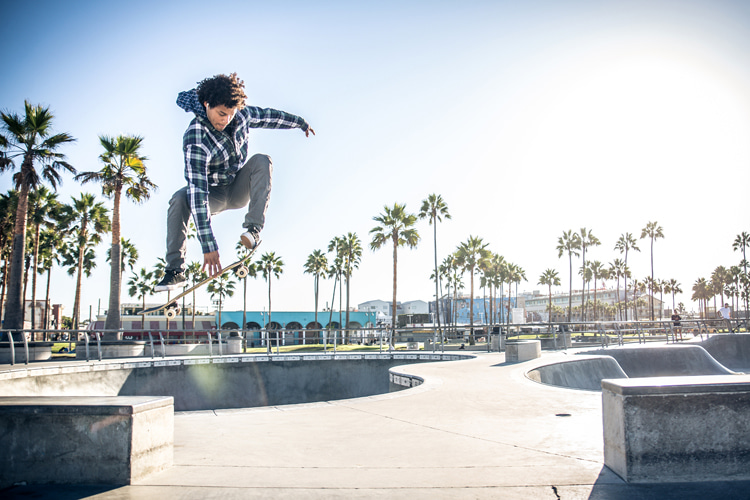
2. Facility Rating
The World Skate rating system aims to provide a quantifiable, easy-to-understand evaluation of the quality of a skateboard facility.
The rating evaluation comprises the quality of design and construction, and it is expressed in stars numbered from 1 to 5.
Different sections of the same facility may have different class certifications and ratings. Evaluation criteria include the following:
a) Sport Technical Criteria
- Skatepark footprint;
- Creativity of design;
- Functionality and versatility of the design;
- Quality and number of flow-lines;
- Quality and variety of materials;
- Quality of Construction and finishing;
- Availability of additional space for competition time facilities;
- Lighting system availability;
b) Social Utility Criteria
- Availability and quality of permanent support facilities (Skate shop, clubhouse, toilets, etc.);
- Availability and quality of resting and socializing areas;
- Urban landscape integration;
- Level of landscape integration;
- Proximity to public transport;
- Parking lot availability;
The rating of a skateboard facility will be provisionally assigned during the design phase and will be confirmed or re-evaluated upon completion of construction.
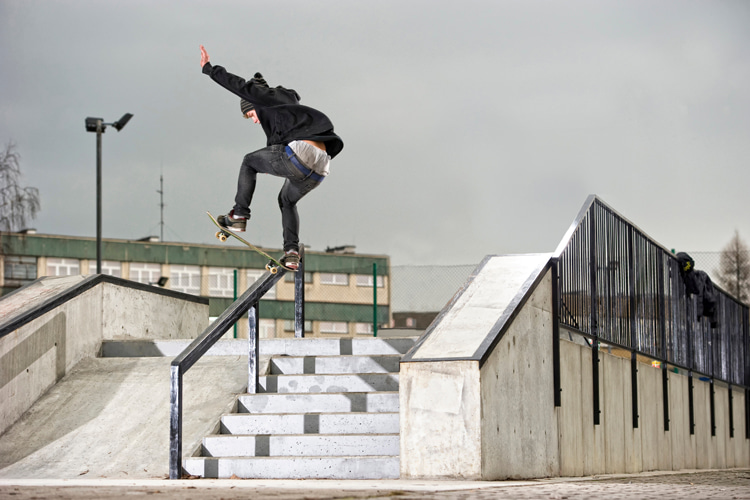
3. Olympic Games Competition Facilities
The Skateboarding facilities serving as "Field Of Play" (FOP) for the Olympic Games are considered the pinnacle of design and construction quality.
For this reason, Olympic Tier FOPs are required to achieve a 5-Star C-Class certification.
4. Safety Standard Compliance
While adhering to the principles contained in this document, every skateboard facility falls under the applicable rules of its local and national safety standards.
5. General Characteristics
Location
The skatepark should be located in or near an urban area and be adequately integrated into the environment and existing infrastructure of services in the area.
The facility must be easily accessible by spectators and by all users of different categories (athletes, media, public, etc.), according to a plan that considers local traffic and transportation, urban regulations, civic customs, and habits.
In relation to this, it is necessary that parking facilities are available and adequate for the number of users, athletes, spectators, and staff expected both for regular daily use and for extended use during events.
Designated and suitable parking areas reserved for people with disabilities must be provided in compliance with local regulations on easy, safe, and practical access to the venue.
Fencing
World Skate doesn't require any permanent fencing for a facility to be certified.
However, World Skate international competition standards require the field of play, as well as the event area, to be fenced during practice and competition time.
Inquire World Skate for the skateboarding competition handbook for reference.
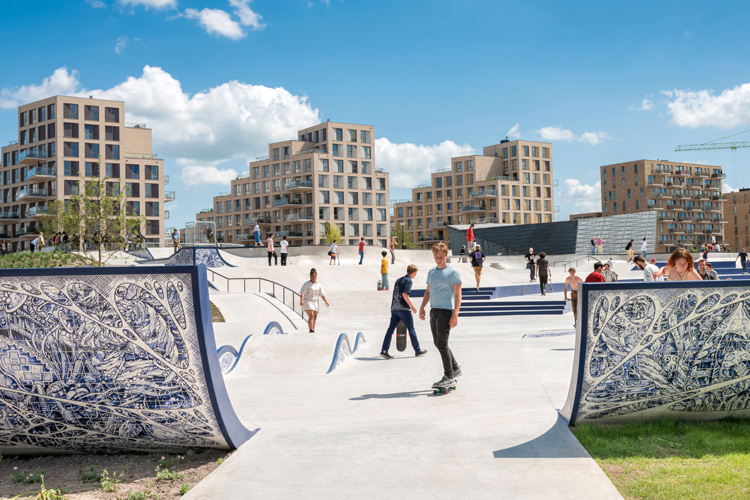
6. Size of Competition Facilities
While there are no footprint size requirements for a Recreation Class facility, Competition Class facilities must be designed within a specific footprint range.
The minimum area requirement guarantees enough space to practice safely and the ability to have an adequate range of obstacles on the FOP.
The maximum area requirement allows for the efficient use of the space during a standard competition run ranging from 45 to 60 seconds.
If the designers are required to plan for an extensive public facility, a competition area should be identified and adequately designed within the broader facility plan.
- Street > Minimum: 950 sqm/10.000 sqm | Maximum: 1900 sqm/20.500 sqft;
- Park > Minimum: 800 sqm/8600 sqm | Maximum: 1700 sqm/18300 sqft;
Exceptions may be granted for skateparks offering efficient flow lines. This applies in particular to temporary competition skateparks, especially when built indoors.
Exceptions are considered and granted case by case with particular reference to facilities built before June 1, 2022.
The minimum area is the planimetric area (footprint) that can be used for the practice (including stateable decks). Spectator and support staff areas are not included.
Side by Side Skateparks
When FOPs for different discipline areas are built next to each other, a minimum 10-meter wide and preferably flat aisle must be available between them.
This is especially needed if the facility is meant to host multi-discipline competitions.
This area can be either a skateable area of the facility connecting the two FOPs or, rather, a non-paved buffer zone between the two FOPs.
The Shape of a Skatepark
For both street-style and park-style courses, the shape and layout are left to the creative freedom of the designer and are not required to adhere to any standard shape.
Unique and creative designs are encouraged, as well as their integration into a given site's natural geography.
It remains the exclusive right of World Skate to assess the characteristics and suitability of the design.
However, in order to prevent any potential organizational issues, the design of the proposed course and its surrounding areas should keep in mind the needs, logistics, and characteristics of a skateboard competition.
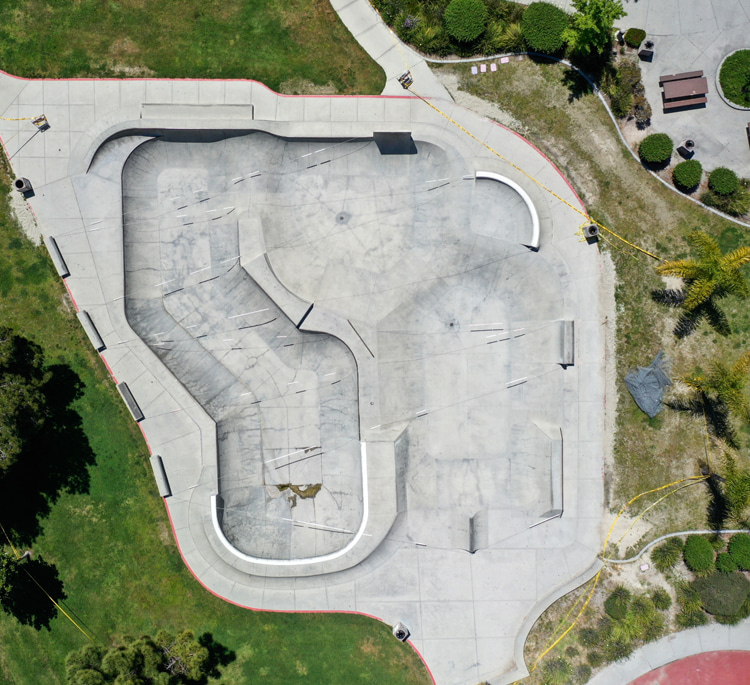
7. Structure and Characteristics of the Competition Class Facility
The number, size, and design of the elements and sections in a skatepark are crucial for defining the quality and intended use of the course.
An "obstacle" is defined as a single ramp, slope, curb, rail, or other feature of a skatepark.
The obstacles can be designed in continuity (typical format of a park-style skatepark) or in a more isolated configuration (typical format of a street-style skatepark).
While skatepark design must always comply with domestic safety regulations and standards, the designer is free to size, combine, characterize and distribute the obstacles at his/her own discretion.
Nonetheless, the designer is encouraged to create alternative shapes that promote the progression of skatepark design and skateboarding as a whole.
While staying compliant with applicable domestic safety regulations, the designer is given the freedom to choose the quantity and quality of the obstacles that create a unique skatepark.
The inventions, modifications, and integration of new obstacle shapes and their functional layout within a skatepark are considered a virtue and are a highly valued quality of skatepark designers.
The non-standardization and ongoing evolution of skatepark design are essential for skateboarding to thrive and progress.
For this reason, this standard does not intend to provide precise or binding prescriptions about the nature and quantity of structures presented in a skatepark but limits itself to outlining the minimum parameters of surface area with the necessary height of obstacles.
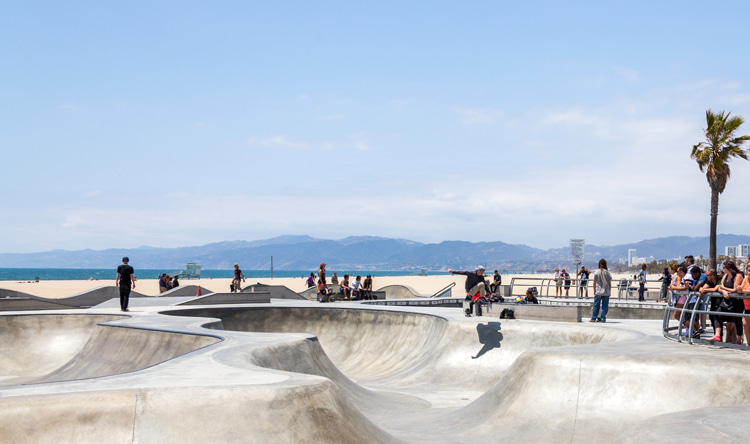
8. Dimensions and Type of Obstacles
Park-Style
In order to allow the widest range and variety of skateboarding styles, a course must include a number of sections offering different features and depths:
a) Shallow End: Lower section with assorted heights not exceeding 1.8 meters;
b) Deep End: Deep section with a height of no less than 2.4 meters, including a vertical section;
Provided that the facility includes a shallow and a deep section as described above, all intermediate depths/heights between those of the deep and shallow sections are allowed.
Both shallow and deep-end areas within the course should contain various features such as hips, spines, banks, vertical walls, volcanos, love seats, etc.
The edging or coping may include both metal pipe and/or concrete swimming pool-style coping (pool coping).
A reasonable level of tolerance will be adopted in evaluating measurements in countries using standard imperial units.
Street-Style
Street-style courses should include a wide range of features and elements such as rails, ledges, banks, stairs, walls, gaps, etc.
The selection, positioning, and design of these features must allow athletes of different ability levels to perform various types of tricks and use the skatepark without any limitations imposed by their natural stance.
a) Big Section: The largest stair section or gap should be between 1.2 m and 1.6 m in height and include either rails, "Hubba" ledges, or both. While a big section, as described above, must be featured in every skatepark, stair sets and gaps bigger than 1.6m are allowed but not demanded;
b) Lower Sections: The smaller stair and bank sections should be less than 0.8 m in height and should also include rails, ledges, or both;
Provided that the facility includes both a big and a small section as described above, all intermediate heights between small and big sections are allowed.
A reasonable level of tolerance will be adopted in evaluating measurements in countries using standard imperial units.
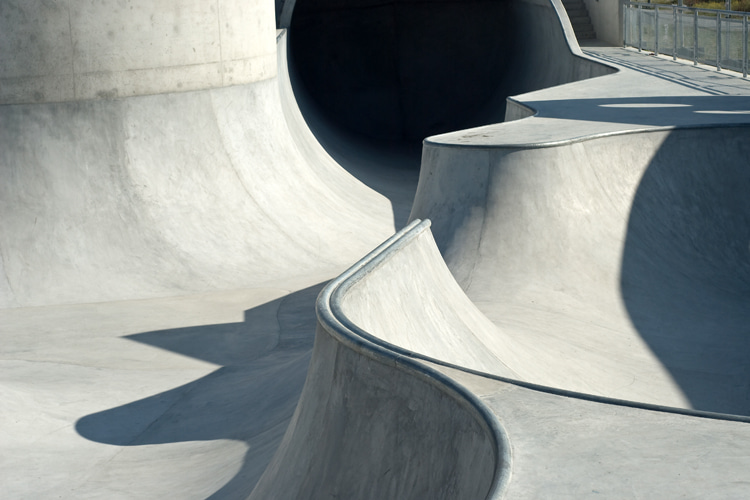
9. Flow Line
The term flow line refers to a common characteristic found in any skatepark that can be described as follows:
"The ability to skate through the whole course in various ways with an adequate speed to perform tricks of different types, with various amplitudes and technical levels, using a limited effort to continue without any forced interruption caused by the design of the course."
The quality of the flow and its efficiency depends on:
a) The positioning of features and elements throughout the skatepark;
b) Geometric characteristics (height, inclination, width, curvature, etc.) of features and elements;
c) Materials and finishing of rolling surfaces;
Efficient flow lines provide athletes with adequate speed, enabling the execution of multiple tricks in succession without the need to stop or step off the skateboard.
Well-designed flow lines also help to enable safe and efficient circulation in the skatepark when many athletes are using the course at the same time.
The quantity and quality of the lines available in a skatepark must take absolute priority in the design phase and will be subject to careful evaluation by World Skate.
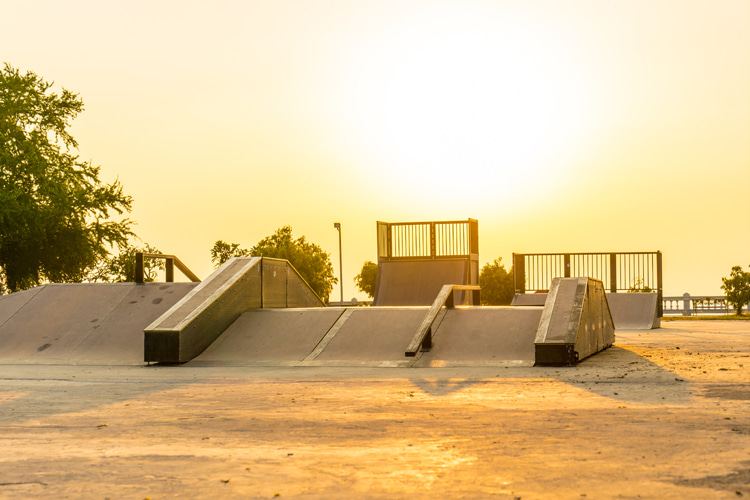
10. Skateable Surfaces
The term "skateable surfaces" refers to all the rolling surfaces within the facility, including:
a) Horizontal floors;
b) The flooring of banked/sloped surfaces;
c) Surface of curved sections;
All skateable surfaces must be perfectly smooth, not slippery, and ensure the sufficient adherence of skateboard wheels.
Flooring Types Allowed
Outdoor Permanent Facilities
Outdoor permanent facilities are required to offer skateable concrete surfaces with perfect finishing.
Different materials may be used for aesthetic purposes or to intentionally create various technical or performance challenges.
These features must be limited only to a small portion of the skatepark floors and to a limited number of obstacles.
Temporary Competition Facilities
Indoor and outdoor temporary competition facilities designed to host international events (Continental Championships excluded) must predominantly offer concrete skateable surfaces.
This applies with specific focus to areas and obstacles required to offer the degree of rigidness, rebound, and elasticity needed for elite-level skateboarding.
The combination of materials used, along with their selective employment, must always be approved by World Skate.
Indoor Permanent Facilities
Permanent indoor facilities not meant to host International Events (Continental Championships excluded) can offer wood, MDF, or HPL skateable surfaces.
When using any other materials, the surfaces must show adherence characteristics and rigidity comparable to cement.
The support structure must be firm and not flexible or elastic.
Surface Regularity of the Flat Areas
The surface must be perfectly smooth.
The deviations allowed on the finished surfaces and on the sliding surfaces must comply with the standards below.
Surface Regularity Of The Curved Sections
The surface of the curved sections must correspond to the section defined in the project.
Assays made with a curvilinear template on the sliding surface must not show deviations greater than 1% of the radius of curvature, with a maximum of 2 cm.
Slopes Of The Pavement
In indoor installations, the surface must be horizontal.
In outdoor facilities, in order to allow stormwater management, slopes of at least 1% are recommended, with a maximum admission of 2%.
In all cases, areas that naturally produce water stagnation must be avoided during the design phase.
Where this is not possible to achieve, the facility must be equipped with rainwater drainage systems.
Friction
The surface must grant an adequate level of grip to skateboard wheels. We suggest performing grip tests before starting construction.
Smoothness
The surface must have a high degree of smoothness in order to minimize the rolling friction of the skateboard wheels.
The requirements are currently being studied by World Skate and will be published in due course.
Color
The color of the flooring should not have overly dark or bright color tones and should consider athlete safety, sun reflections, and exposure issues related to television shoots and event broadcasts.
The possible use of paints, pigments, or resins must not compromise the optimal adhesion and smoothness of the surface of the FOP.
Drainage
The flooring must have an efficient drainage system, especially in the park-style areas.
The manhole covers and drainage, when present, must not alter the continuity and characteristics of the rolling surface nor constitute a safety hazard for athletes - the manhole covers and drainage must be equipped with an anti-lift system.
Indoor Installations
For indoor facilities with decks up to 300 cm high, the clearance above the highest platform must be at least 250 cm.
In the case of platforms higher than 300 cm, at least 300 cm of clearance must be maintained from platform to ceiling.
Lighting
While permanent lighting is not required to receive a baseline certification, equipping the facility with a lighting system is generally strongly recommended for any public and competitive facility.
The course must be lit by means of a fixed or mobile artificial lighting system.
Particular attention must be paid to avoiding direct glares or spotlight effects on the athletes.
There must be a minimum illumination of 150 lux on the horizontal plane of the FOP, with a coefficient of uniformity (minimum luminance / average luminance) equal to 0.7.
The security lighting system must be capable of automatically and instantly switching on in case of a power shortage.
For further details, refer to domestic safety regulations.
Support Services For Competitions
When planning a Competition Class facility, the designer must take into consideration the need for a series of temporary infrastructures required for hosting competitions.
While a more detailed description can be found in the World Skate competition handbook, a streamlined list with a basic description is provided below:
Sanitary Facilities (Area TBD)
Sanitary facilities must be available throughout the whole duration of the event. Gender-designated and separated sanitary facilities must be provided to athletes, spectators, and staff.
The quantity of the facility must follow local regulations.
Judging Booth (14-24 sqm)
Sheltered, climatized, and located in the vicinity of the competition area, providing a direct and comprehensive view of the FOP without any interference from unauthorized staff, athletes or spectators.
Sports Presentation Booth (8-16 sqm)
Sheltered and located in the vicinity of the competition area, the size of the booth depends on the size and complexity of sports presentation operations.
Athletes and Support Staff Lounge (50-100 sqm)
Competitors and National Federation staff must be granted a restricted access area to relax and rest.
The athletes and support staff lounge must be close to the FOP and provide safety, shade, and sufficient seating.
The size of the athlete's lounge should be appropriate for the expected number of athletes participating in the competition.
First Aid Support Area (9 sqm minimum)
A designated sheltered, safe, and quiet area must be available for first aid and medical staff.
Anti-Doping Rooms (15-20 sqm)
For the duration of the competition, a specific area must be equipped as the WADA requirements-compliant anti-doping station.
Spectators, VIP, Media, and Guest Areas (Area TBD)
The facility must be equipped with areas, designated paths, and services for spectators (stands), media (office), guests, and VIPs (lounge), and also consider the presence of people with disabilities.
Areas for Media and Television Installations (Area TBD)
In case of high-level competition, the facility must offer areas, routes, and services for the press and television crews.
Additional Areas (Area TBD)
Additional support service areas, such as catering and parking, must be available.
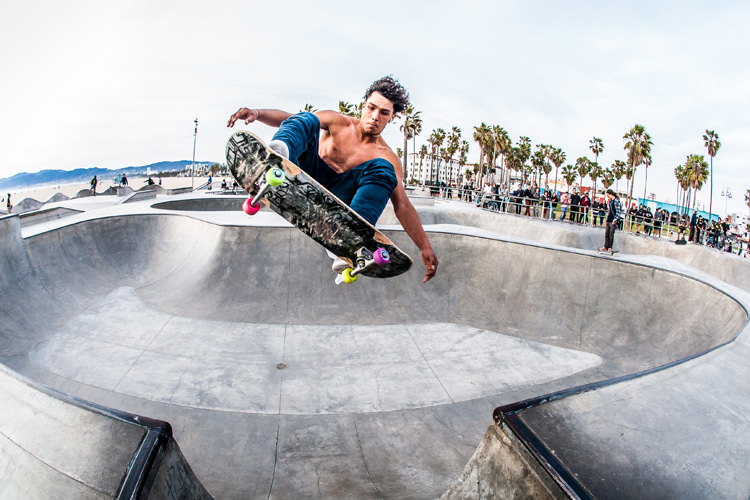
11. The Certification Process
The World Skate Facility Department is the sole entity responsible for the World Skate Certification for Skateboarding Facilities.
While a World Skate Competition Class certification is required for facilities aiming to host official events, the Recreation Class certification should be sought to guarantee that facilities of any size and purpose meet the highest standards of skatepark design and construction.
The following phases must be completed in order to obtain a World Skate Facility Certification.
Phase 1 - Design Review and Approval
The certification process always starts with a design review.
Following the submission of the required documents, the World Skate Facility Department will provide a report highlighting the following details:
a) Potential certification class and rating;
b) Recommendations for improvements (where needed);
In the case of necessary design improvements, the World Skate Facility Department will conduct a second review as included in the original review fee.
A "design approval" doesn't directly lead to a certified facility.
Skateparks can only be certified after the build has been completed, World Skate has verified its completion, and the facility has been tested by a World Skate official.
Phase 2 - Facility Inspection
No facility can be certified prior to a site inspection.
A World Skate official will be appointed to personally inspect the newly completed facility.
During the inspection, the facility will be checked against the approved designs.
The skatepark will be scrutinized, with specific attention paid to the quality of construction, details, and surface finishing.
Phase 3 - Certification Release
Upon receiving the Facility Inspection Report, the World Skate Facility Department will issue a final document with the class and rating certification.
Suggestions, comments, and prescriptions may be attached to the Certification document.
While suggestions and comments are made for reference only, prescriptions will outline the binding actions to be undertaken for the final validation of the certificate.
Validity of a Certification
Due to the natural wear and degradation of construction materials, a World Skate Facility certification is valid for five years.
After the initial 5-year period, Facilities can apply for renewal of their certification.
